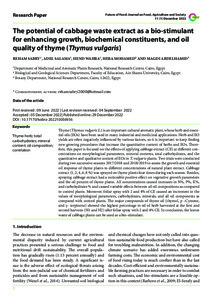| dcterms.abstract | Thyme (Thymus vulgaris L.) is an important cultural aromatic plant, whose herb and essential oils (EOs) have been used in many industrial and medicinal applications. Herb and EO yields are often negatively influenced by various factors, so it is important to keep finding new growing procedures that increase the quantitative content of herbs and EOs. Therefore, this paper is focused on the effects of applying cabbage extract (CE) at different concentrations on morphological parameters, mineral contents, total carbohydrates, and the quantitative and qualitative content of EOs in T. vulgaris plants. Two trials were conducted during two successive seasons 2017/2018 and 2018/2019 to assess the growth and essential oil response of thyme plants to different concentrations of natural plant extract. Cabbage extract (1, 2, 4, 6, 8 %) was sprayed on thyme plants four times during each season. Besides, spraying cabbage extract had a noticeable positive effect on vegetative growth parameters and the oil percent of thyme plants. All concentrations caused increases in N%, P%, K%, and carbohydrates % and caused variable effects between all oil compositions as compared to control plants. Moreover, foliar spray with 2 and 4% of CE caused an increment in the values of morphological parameters, carbohydrates, minerals, and all oil components as compared with control plants. The major compounds of thyme oil (thymol, p –Cymene, and γ- terpinene) showed the highest percentage in oil of herb harvested at the first and second harvests (H1 and H2) after foliar spray with 2 and 4% CE. In conclusion, the leaves waste of cabbage plants can be used as a bio-stimulant. | eng |


